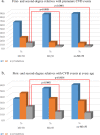Younger age of patients with myocardial infarction is associated with a higher number of relatives with a history of premature atherosclerosis
- PMID: 32912162
- PMCID: PMC7488448
- DOI: 10.1186/s12872-020-01677-w
Younger age of patients with myocardial infarction is associated with a higher number of relatives with a history of premature atherosclerosis
Abstract
Background: Premature coronary artery disease is one of the most pressing global issues in modern cardiology. The aim of the study was to investigate the role of family history of premature cardiovascular disease (CVD) in patients aged < 50 years with myocardial infarction (MI) compared to that in patients aged ≥50 years with MI and to that in young people without MI (no-MI < 50).
Methods: The studied group (MI < 50) consisted of 240 patients aged 26-49 years with MI. The control groups consisted of 240 patients (MI ≥ 50) with MI aged 50-92 years and 240 healthy people aged 30-49 years without a history of MI (no-MI < 50).
Results: There were statistically significant differences between the MI < 50 and MI ≥ 50 and no-MI < 50 groups regarding the family history of premature MI/ischaemic stroke and the percentage of patients with ≥2 relatives affected (10.8, 2.9, and 3.7%, respectively; p < 0.0001). There was a statistically significant difference in the patient age at the first MI occurrence among patients without a family history of premature CVD, those with 1 affected relative, and those with ≥2 affected first-degree relatives (56.6, 48.6 and 41.8 years, respectively) as well as those with affected first- and second-degree relatives (56.5, 50.7 and 47.0 years, respectively).
Conclusions: A younger age of patients with myocardial infarction is associated with a higher number of relatives with a history of premature MI/ischaemic stroke. Thus, the family history of premature atherosclerosis involving not only first- but also second-degree relatives seems to be a valuable factor in CVD risk evaluation in young people.
Keywords: CVD family history; Myocardial infarction at a young age; Premature coronary artery disease.
Conflict of interest statement
The authors declare that they have no competing interests.
Figures


Similar articles
-
Myocardial Infarction in the Young: Aetiology, Emerging Risk Factors, and the Role of Novel Biomarkers.J Cardiovasc Dev Dis. 2025 Apr 10;12(4):148. doi: 10.3390/jcdd12040148. J Cardiovasc Dev Dis. 2025. PMID: 40278206 Free PMC article. Review.
-
Familial risk of myocardial infarction with non-obstructive and obstructive coronary arteries: a nation-wide cohort study.Eur J Prev Cardiol. 2025 Jun 3;32(8):671-679. doi: 10.1093/eurjpc/zwae313. Eur J Prev Cardiol. 2025. PMID: 39373562
-
Intronic SYNE1 Gene Novel Variant Associated with Myocardial Infarction in Young People with a Family History of Premature Atherosclerosis: A Case-Control Study in the Polish Population.Int J Mol Sci. 2025 Mar 3;26(5):2244. doi: 10.3390/ijms26052244. Int J Mol Sci. 2025. PMID: 40076866 Free PMC article.
-
Family history does not predict angiographic localization or severity of coronary artery disease.Atherosclerosis. 2012 Apr;221(2):451-7. doi: 10.1016/j.atherosclerosis.2012.01.033. Epub 2012 Jan 30. Atherosclerosis. 2012. PMID: 22341867
-
Premature Myocardial Infarction in the Middle East and North Africa: Rationale for the Gulf PREVENT Study.Angiology. 2020 Jan;71(1):17-26. doi: 10.1177/0003319719849737. Epub 2019 May 26. Angiology. 2020. PMID: 31129986 Free PMC article. Review.
Cited by
-
Prevalence and Risk Factors for Atherosclerotic Cardiovascular Disease in 7704 Individuals: An Analysis from the Greek Registry for the Prevalence of Familial Hypercholesterolemia (GRegistry-FH).J Cardiovasc Dev Dis. 2024 Dec 23;11(12):411. doi: 10.3390/jcdd11120411. J Cardiovasc Dev Dis. 2024. PMID: 39728301 Free PMC article.
-
G Protein-Coupled Receptor 15 Expression Is Associated with Myocardial Infarction.Int J Mol Sci. 2022 Dec 22;24(1):180. doi: 10.3390/ijms24010180. Int J Mol Sci. 2022. PMID: 36613626 Free PMC article.
-
Premature Myocardial Infarction: A Rising Threat.Balkan Med J. 2022 Mar 14;39(2):83-95. doi: 10.4274/balkanmedj.galenos.2022-2-19. Balkan Med J. 2022. PMID: 35330552 Free PMC article. Review.
-
Identifying Risk Indicators of Cardiovascular Disease in Fasa Cohort Study (FACS): An Application of Generalized Linear Mixed-Model Tree.Arch Iran Med. 2024 May 1;27(5):239-247. doi: 10.34172/aim.2024.35. Arch Iran Med. 2024. PMID: 38690790 Free PMC article.
-
Myocardial Infarction in the Young: Aetiology, Emerging Risk Factors, and the Role of Novel Biomarkers.J Cardiovasc Dev Dis. 2025 Apr 10;12(4):148. doi: 10.3390/jcdd12040148. J Cardiovasc Dev Dis. 2025. PMID: 40278206 Free PMC article. Review.
References
-
- Trzeciak P, Wożakowska-Kapłon B, Niedziela J, Gierlotka M, Hawranek M, Lekston A, et al. Comparison of Inhospital and 12- and 36-month outcomes after acute coronary syndrome in men versus women <40 years (from the PL-ACS registry) Am J Cardiol. 2016;118:9. doi: 10.1016/j.amjcard.2016.07.067. - DOI - PubMed
-
- Gierlotka M, Zdrojewski T, Wojtyniak B, Poloński L, Stokwiszewski J, Gąsior M, et al. Incidence, treatment, in-hospital mortality and one-year outcomes of acute myocardial infarction in Poland in 2009-2012--nationwide AMI-PL database. Kardiol Pol. 2015;73:3. doi: 10.5603/KP.a2014.0213. - DOI - PubMed
Publication types
MeSH terms
Grants and funding
LinkOut - more resources
Full Text Sources
Medical

